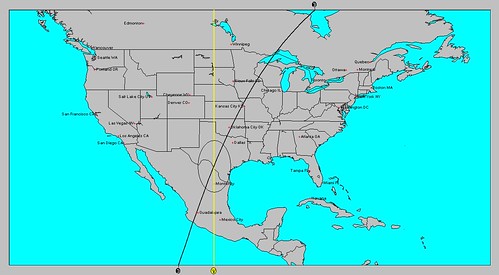The First Quarter Moon of February 11, 2011 sets up a potentially wet weather pattern for the South Texas Plains region.

As shown on the accompanying map, at the time of the First Quarter Moon, Neptune and the Moon occupy angular positions. That is to say as the Moon is setting to the west, Neptune will be anti-culminating or reaching its lowest point (directly underneath the earth).
Around the 17th, the Sun will oppose Neptune and spark this planetary combination over the Rio Grande about 150 miles southwest of San Antonio, Texas. Neptune , the most pluvial of all the celestial bodies, foreshadows abundant moisture and threatens flooding in those regions where it occupies the meridian.
Significant West Coast Storm February 20-23, 2011
Major Storm January 3-5, 2011
Midwest Winter Cold and Heating Oil
December 2010 Nor'easter Forecast
Tropical Storm Matthew Fulfills Long-range Forecast!
Hurricane Earl and T.D. 10E Fulfill Long-range Forecasts!
Tropical Storm Alex Fulfills Long-range Prediction!
Bonnie Fulfills Long-range Forecast!
Introduction to the Weather Alternative
How Long-Range Forecasts Are Made

As shown on the accompanying map, at the time of the First Quarter Moon, Neptune and the Moon occupy angular positions. That is to say as the Moon is setting to the west, Neptune will be anti-culminating or reaching its lowest point (directly underneath the earth).
Around the 17th, the Sun will oppose Neptune and spark this planetary combination over the Rio Grande about 150 miles southwest of San Antonio, Texas. Neptune , the most pluvial of all the celestial bodies, foreshadows abundant moisture and threatens flooding in those regions where it occupies the meridian.
Significant West Coast Storm February 20-23, 2011
Major Storm January 3-5, 2011
Midwest Winter Cold and Heating Oil
December 2010 Nor'easter Forecast
Tropical Storm Matthew Fulfills Long-range Forecast!
Hurricane Earl and T.D. 10E Fulfill Long-range Forecasts!
Tropical Storm Alex Fulfills Long-range Prediction!
Bonnie Fulfills Long-range Forecast!
Introduction to the Weather Alternative
How Long-Range Forecasts Are Made

No comments:
Post a Comment